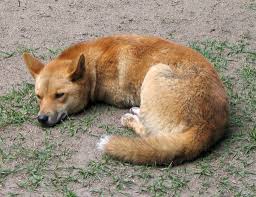The Dingo is a free-roaming wild Australian canid that has several features which set it apart from other canine species. With short fur ranging from shades of yellow, to mixes of red and yellow or red and brown, it has a wolf-like head, eyes whose color vary from yellow to orange, small and erect ears, long legs and well furred tail. Albino dingoes have also been observed. This breed is commonly associated with Australia, however it can be found in Southeast Asia also (e.g., Indonesia, Malaysia and Burma). Actually, it is thought that dingoes have been brought to Australia by aboriginal settlers from Southeast Asia some 3,000 to 4,000 years ago. Currently, given that interbreeding with European dogs has been introduced to the Australian continent, the purebred dingo gene pool has registered a decline.

Since it has never been fully domesticated, this canid can be found living alone in the wild or in cooperative packs of up to ten members. Its natural habitat can vary from deserts, to areas close to forests and grasslands, but never too far away from water. However, water is a barrier for dingoes, as they will not swim but only wade. These canids will make abandoned rabbit holes and hollow tree logs their homes. Although the Dingo is almost never kept as a human companion, it can be trained into becoming a pet if it is adopted before the age of six weeks. It responds well to kindness and patience and this type of attitude is the appropriate one for teaching this dog to become obedient.
Where its hunting behavior is concerned, this canid will hunt alone or in family units. Before going hunting, which usually happens during night time, these families can be heard as they vocalize together. There is a distinctive yelp or howl used by dingoes to communicate with each other and they only rarely bark, usually when giving warnings. A number of approximately 170 species, ranging from insects to buffalo, has been associated with the dingoes diet. However, these wild dogs will mostly feed on red kangaroo, cattle, possum, rabbit, dusky rat or common wombat. It can be said that they are rather specialized, with ten species covering about 80 percent of their diet. As apex predators and Australias largest terrestrial predators, dingoes play an important part in this continents ecosystems.
There are some unusual traits that can be found in dingoes. For example, they are very good tree climbers and they choose a mate for life, which is not common with other dogs. After losing its partner, this dog will sometimes mourn it to death. Where the breeding cycle is concerned, this resembles that of the wolf, since the female goes through just one breeding cycle during the course of a year.
With a life expectancy of 20 years, dingoes are mostly known as being part of Australias wildlife, but they can also be found living in Southeast Asia. Although not impossible to be tamed, the dingo will rarely be kept as a companion but, within its wild territory, it will play an important role on Australian ecosystems.




